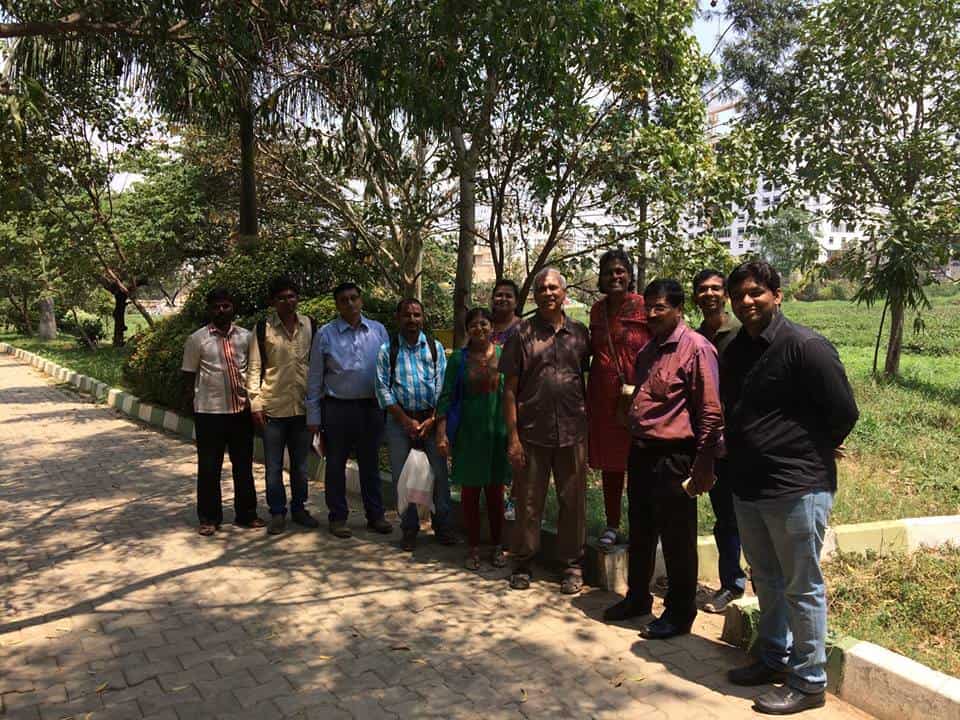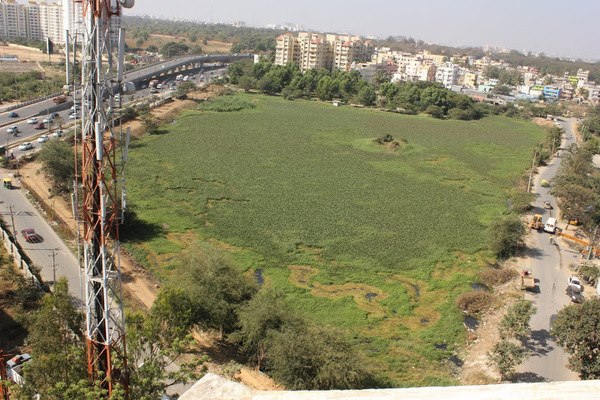Iblur lake is almost ready! Those of you who travel by the lake may have noticed that the lake bed has been cleaned and levelled, the bund has been built, and bund walls pitched with stone. Water inlets and outlets have been constructed, and the newly built storm water drains along Outer Ring Road will bring rainwater runoff into the lake. Once Hoskote Gravel is laid on the bund, the walking/jogging path would be complete.
Joggers and walkers have already started using the lake. Birds also make occasional stopovers. We, local residents who had formed the Iblur Lake Forum, are now working with the BBMP Horticulture Department to select native tree species to be planted along the perimeter of the lake.
By June, a STP of 250 KLD (Kilo Litres per Day) capacity will be set up to feed the lake with treated water. A wetland has been designed to hold the treated water briefly, for further purification, before letting it into the lake. Once we finish planting trees, and have water flowing into the lake bed, the lake will come alive. We will also have toilets, drinking water facility, and a security room in place by June.
We must thank the BBMP Lakes Department led by Chief Engineer B V Satish (now retired), DCF (Deputy Conservator of Forests) Jagannatha Rao, Assistant Engineer Shilpa Karthik, and their contractor, for making this six-year dream of ours a reality. Lakes Department was very patient and more than willing to provide funds beyond their budget, to fulfil some of our requests.

BBMP Lakes Department officials with the members of Iblur Lake Forum, during a survey of the lake last year. Pic: IbEnT
Why did the lake need restoration?
Iblur lake’s decline had started with the construction of Iblur flyover. Those who have lived in this neighbourhood long enough would know that the lake boundary used to lay across ORR, close to the Microsoft campus. A stretch of ORR was built upon the lake itself. The land next to the Cafe Coffee Day (CCD) outlet, on which a three-storey illegal structure stands now, was also once part of the lake.
Once the flyover became operational, herons, egrets, ducks, frogs and fish gave way to raw sewage, paper and plastic waste, construction debris, liquor bottles, and waste from hair salons. BDA conveniently buried a sewage pipe – which they called a storm water drain – at Iblur, across ORR. With this, raw sewage started entering the lake rapidly. By 2011, the lake had been reduced to a toxic cesspool in which no life form could survive. It had shrunk to around 10 acres, from its original spread of 18 acres.

The pristine lake was covered by muck and hyacinth by 2011. Pic: IbEnT
Sometime in 2013, citizens started petitioning BDA, the then-custodian of the lake, to restore it. After two years of persistent follow-up and letters, and meetings with the Lokayukta, BDA agreed to fence the lake to protect it from further encroachment. Citizens even managed to force the hand of the tahsildar to demolish the illegal structure next to CCD; however the encroacher continues to occupy the land.
Finally, realising that BDA did not have the will to work on the lake, citizens sought the help of former HSR Corporator Latha Narasimhamurthy to transfer the lake from BDA to BBMP. By 2016, the lake was firmly in the hands of the BBMP Lakes Department, which had a track record of restoring many lakes in the city. Citizens were now talking to a more competent organisation, run by professionals who cared.
Work starts in 2017
By late 2016, BBMP Lakes Department put Iblur in the list of lakes to be rejuvenated. In 2017, BBMP officials carried out a survey, issued a tender and then a work order to rejuvenate the lake. By mid-2017, work was started to divert sewage that had been flowing into the lake. Early 2018 saw over 1500 truck loads of silt being removed from the lake bed.

Muck that was removed from the lake bed during restoration. Pic: IbEnT
While the plan was to complete lake rejuvenation by last summer, early rains in April set back the desilting work. The partly-dried lake bed became a soggy mess again, making silt removal and transportation difficult. There were other challenges too, such as finding a spot to move the silt to, violence by local goons, and so on. However, desilting was completed last monsoon, and then other works such as stone pitching started.
Now we are very close to seeing the lake as a place for all to enjoy.
Going forward with citizens’ support
As is the norm, BBMP hands over the lake to citizens for its daily upkeep once rejuvenation is complete. We have formed the non-profit Iblur Environs Trust (IbEnT) to manage the lake once it is handed over to us. IbEnT has reached out to neighbourhood apartment complexes, and people have opened their hearts and wallets to the cause of lake maintenance. A large corporate has come forward to provide funds for both capital and revenue expenditure. Now all we have to do is wait for the rains!
Over the years, several citizens have supported the work of Iblur Lake Forum – through financial contributions, by joining us in discussions with BBMP and contractors, or by simply writing to us. All these have energised us; we thank you for your unstinted support through these difficult six years. We are certain that with your continued support, IbEnT will fulfil its charter – keeping Iblur lake a beautiful community asset for us all to enjoy and nourish.
Goosebumps!
Power to the people. Thank you for teaching us that we are actually powerful!
This is excellent. Hats off to the entire team which made this possible. As a resident of the neighboring area I am very very happy to see this transformation. It is not just the Iblur lake, hats-off to all those involved in the restoration and maintenance of the Kaikkondarahalli lake and also the Agara lake. This is fabulous work. You guys are true citizens of the land 🙂 while most of us are not able to reflect that (even on roads) :-(. At the minimum all others should extend support by not polluting/damaging these lakes further. Not all the cities in India have lakes, so the lakes are also Bengaluru’s pride :-). In our country many things are left to the people to take care of – even basic amenities such as good roads, water, etc. can only be in dreams. To rise above the bureaucratic and challenges of all other kinds it needs great deal of determination and efforts and that’s precisely the people involved here have demonstrated. A big thank you from a citizen of this land :-).
Good News to read!!
Congratulations and Thank you for all the people involved in lake restoration!!
This is great for Bengaluru. I had filed a complaint to BBMP regarding the garbage dumping in the IDBI lake near Jambu Savari Dinne. We will soon lose this lake if we don’t take any action. Request CM to take it up
Shikaripalya lake in electronics city phase 1 getting ignored by panchayat and drainage water getting mixed with lake water. Also localities burn plastic and dry waste near lake. can someone please look at it 🙁